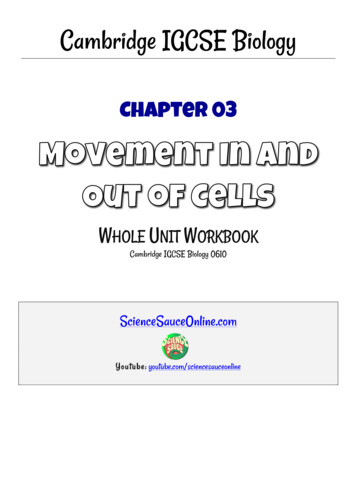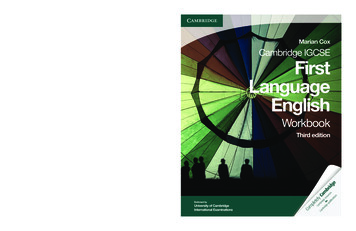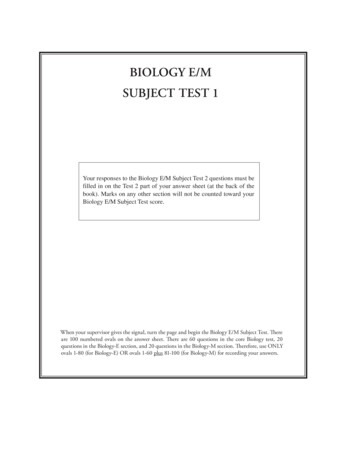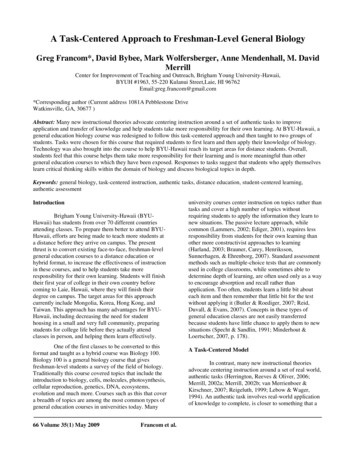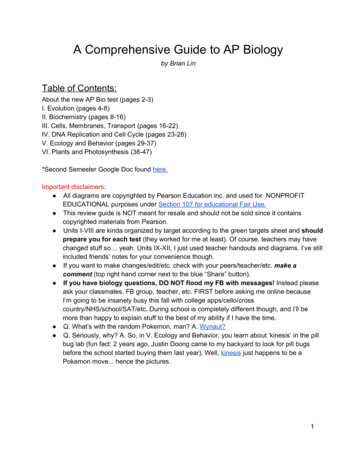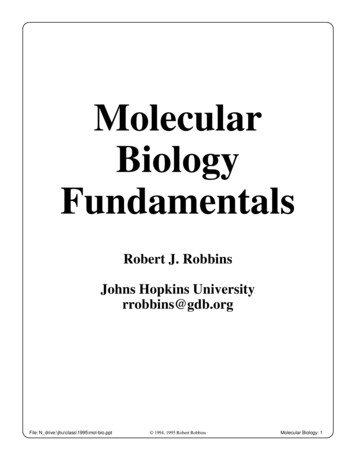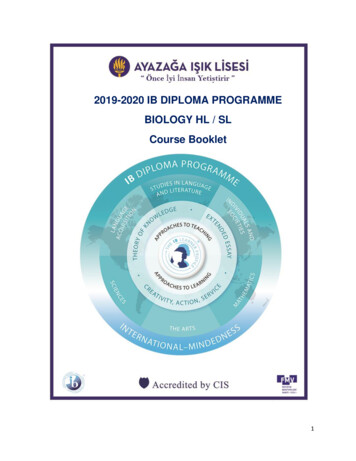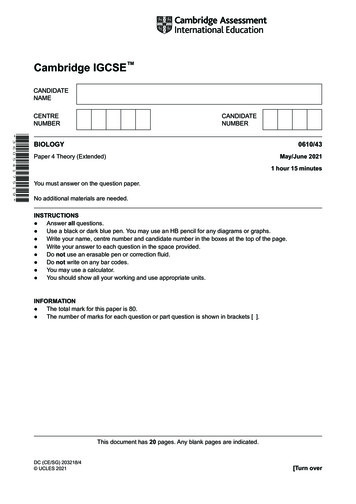
Transcription
Cambridge IGCSE * 3 6 0 5 4 1 7 5 1 9 *BIOLOGY0610/43Paper 4 Theory (Extended)May/June 20211 hour 15 minutesYou must answer on the question paper.No additional materials are needed.INSTRUCTIONS Answer all questions. Use a black or dark blue pen. You may use an HB pencil for any diagrams or graphs. Write your name, centre number and candidate number in the boxes at the top of the page. Write your answer to each question in the space provided. Do not use an erasable pen or correction fluid. Do not write on any bar codes. You may use a calculator. You should show all your working and use appropriate units.INFORMATION The total mark for this paper is 80. The number of marks for each question or part question is shown in brackets [ ].This document has 20 pages. Any blank pages are indicated.DC (CE/SG) 203218/4 UCLES 2021[Turn over
21(a) (i)The main component of milk is a liquid that is an important solvent in the body.State the name of this solvent. [1](ii)Table 1.1 shows some of the nutrients found in human milk, the elements that make upthe nutrients, the enzymes that digest them and the products of digestion.Complete Table 1.1.Table 1.1nutrientelementsenzymeproducts of digestionproteinfatlactose (milksugar)galactose and glucose(simple sugars)C, H, O[4](b) Milk also contains vitamins and mineral salts.(i)Explain why vitamin D is important for the nutrition of children. [3] UCLES 20210610/43/M/J/21
3(ii)Explain why iron is important in the diet. [2](c) Rubella and kwashiorkor are two diseases that affect children.Rubella is a transmissible disease and kwashiorkor is a non-transmissible disease.(i)Define the term transmissible disease. [2](ii)Explain why women should be vaccinated against rubella before they reach reproductiveage. [4] UCLES 20210610/43/M/J/21[Turn over
4(iii)Outline the causes of kwashiorkor. [2][Total: 18]2Insulin is a protein made by cells in the pancreas.Fig. 2.1 shows how insulin is made in a pancreatic cell.DNAamino acidsnucleusamino acids assembledto form insulinABnot to scaleFig. 2.1(a) (i)State the name of molecule A in Fig. 2.1. [1](ii)State the name of structure B in Fig. 2.1. [1] UCLES 20210610/43/M/J/21
5(iii)Explain the role of molecule A in protein synthesis, as shown in Fig. 2.1. [3](b) Insulin is secreted from cells in the pancreas when the concentration of glucose in the bloodincreases.Outline the role of insulin. [4](c) State the names of two substances, other than insulin, that are secreted by the pancreas.1 .2 .[2][Total: 11] UCLES 20210610/43/M/J/21[Turn over
63Scientists measured the rate of photosynthesis in the leaves of a sunflower plant, Helianthusannuus.The scientists used the apparatus shown in Fig. 3.1 to measure the rate of photosynthesis.direction of air flowair flow regulatorchamber 1chamber 2temperature 20 CCO2 400 ppmchamber 3CO2 360 ppmtimer00:00Fig. 3.1(a) The apparatus in Fig. 3.1 maintains a constant temperature and a constant humidity.(i)Explain why temperature has an effect on the rate of photosynthesis. [4] UCLES 20210610/43/M/J/21
7(ii)Explain why the rate of photosynthesis will decrease if the humidity in the apparatusbecomes very low. [3](iii)The apparatus was left for 15 minutes.Explain how the scientists would use the readings for the concentration of carbon dioxidein chambers 1 and 3 to calculate the rate of photosynthesis. [2] UCLES 20210610/43/M/J/21[Turn over
8(b) The scientists carried out another investigation using the same apparatus at differenttemperatures.They measured the rate of uptake of carbon dioxide in the light and then they measured therate of release of carbon dioxide in the dark.The results are shown in Fig. 3.2.160140CO2 uptakein the light120rate of carbondioxide uptakeand release/ μg per hourper cm2 of leaf1008060CO2 releasein the dark4020015202530temperature / C3540Fig. 3.2(i)Use the information in Fig. 3.2 to complete Table 3.1.Table 3.1temperature/ Crate of uptake of carbon dioxide inthe light / μg per hour per cm2 of leafrate of release of carbon dioxide inthe dark / μg per hour per cm2 of leaf90452035[2] UCLES 20210610/43/M/J/21
9(ii)The scientists determined that photosynthesis in the leaves at 35 C used carbon dioxideat a rate of 135 μg per hour per cm2 of leaf. Fig. 3.2 shows that the rate of carbon dioxideuptake at 35 C was 90 μg per hour per cm2 of leaf.Explain why the rate at which carbon dioxide is used in photosynthesis is greater thanthe rate of carbon dioxide uptake. [2](iii)Explain why the results in Table 3.1 are expressed as ‘per cm2 of leaf’ rather than ‘perleaf’. [1] UCLES 20210610/43/M/J/21[Turn over
10BLANK PAGE UCLES 20210610/43/M/J/21
11(c) Some crops are grown in controlled environments. Glasshouses are an example of acontrolled environment. Fig. 3.3 shows a glasshouse where lettuces are growing.Fig. 3.3Discuss the advantages of growing crops in glasshouses. [6][Total: 20] UCLES 20210610/43/M/J/21[Turn over
124There are three species of rhinoceros in Asia. Fig. 4.1 shows an Indian rhinoceros, Rhinocerosunicornis, in a national park being observed by tourists who are riding on an elephant.Fig. 4.1The International Union for Conservation of Nature (IUCN) collects data on animal species andplaces them into categories based on estimated numbers.Table 4.1 summarises the conservation status of the three species of rhinoceros, as available in2020.Table 4.1specieslocationapproximatenumber inthe wildIndian rhinocerosRhinocerosunicornisnational parksin south Nepaland north India3588160Javan rhinocerosRhinocerossondaicusone nationalpark in Java,Indonesia720critically snational parksin Sumatraand Borneo inIndonesia 807critically endangered UCLES 20210610/43/M/J/21approximatenumber incaptivityIUCN categoryvulnerable
13(a) Outline the reasons why large mammals, such as some species of rhinoceros, areendangered. [5](b) In 2013, Cincinnati Zoo in the USA announced that they were hoping to breed togetherrhinoceros that were brother and sister as part of their captive breeding programme.(i)Discuss the problems that using such closely related animals might have for theconservation of rhinoceros. [2] UCLES 20210610/43/M/J/21[Turn over
14(ii)Captive breeding programmes often use artificial insemination.Outline the process of artificial insemination. [3][Total: 10] UCLES 20210610/43/M/J/21
155(a) Table 5.1 shows four functions of the human gas exchange system.Complete Table 5.1 by identifying the part of the human gas exchange system that carries outeach function.Table 5.1part of the human gas exchangesystemfunctioncontracts to decrease air pressure in thelungsallows air to flow between the larynx andthe lungscontracts to lower the ribs in forcedexpirationsite of gas exchange[4] UCLES 20210610/43/M/J/21[Turn over
16(b) Scientists investigated the effect of increasing carbon dioxide concentration in the air onthe rate and depth of breathing. The people who took part in the investigation were healthyvolunteers.The people breathed atmospheric air containing 0.04% carbon dioxide for five minutes.They then breathed air containing 2% carbon dioxide for five minutes and then returned tobreathing atmospheric air for a further five minutes.The results are shown in Fig. 5.1.0.04% CO22% CO20.04% CO270605040percentage30change in rateand depth ofbreathing2010002468–10–20time / minuteskey:rate of breathingdepth of breathingFig. 5.1 UCLES 20210610/43/M/J/2110121416
17Describe the effects of changing the carbon dioxide concentration of the air on the rate anddepth of breathing, as shown in Fig. 5.1. [4](c) Complete the sentences by writing the appropriate word or phrase in the spaces provided.During physical activity the carbon dioxide concentration in the blood increases. Thereason for this is an increase in the rate of . that occurs in the. in muscle cells.The increase in the concentration of carbon dioxide in the blood is detected by the. , which increases the rate and depth of breathing so that carbondioxide can be . from the body. This is important because carbondioxide is a . substance and can cause harm if it accumulates.[5][Total: 13] UCLES 20210610/43/M/J/21[Turn over
186There are four blood groups in the ABO system in humans: A, B, AB and O.The gene that determines blood group has three alleles: IA, IB and Io.(a) Parents with the genotypes IAIo and IBIo are planning to have more children.Complete the genetic diagram to determine the probability that the next child will have bloodgroup O.parental blood groupsparental genotypesABIAIoIBIoPunnett squarephenotypes ofthe children .probability that the child will have blood group O .[4](b) Explain why the ABO blood group system is an example of co-dominance. [2] UCLES 20210610/43/M/J/21
19(c) Fig. 6.1 shows the percentages of the global population with the four different blood groups inthe ABO system.45403530percentage 25of the globalpopulation20151050ABABOblood groupFig. 6.1With reference to Fig. 6.1, explain why the ABO blood group system is an example ofdiscontinuous variation. [2][Total: 8] UCLES 20210610/43/M/J/21
20BLANK PAGEPermission to reproduce items where third-party owned material protected by copyright is included has been sought and cleared where possible. Everyreasonable effort has been made by the publisher (UCLES) to trace copyright holders, but if any items requiring clearance have unwittingly been included, thepublisher will be pleased to make amends at the earliest possible opportunity.To avoid the issue of disclosure of answer-related information to candidates, all copyright acknowledgements are reproduced online in the CambridgeAssessment International Education Copyright Acknowledgements Booklet. This is p
5 UCLES 2021 0610/43/M/J/21 [Turn over . 4 There are three species of rhinoceros in Asia. Fig. 4.1 shows an Indian rhinoceros, Rhinoceros . This is produced for each series of examinations and is freely available to download
